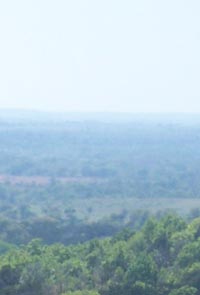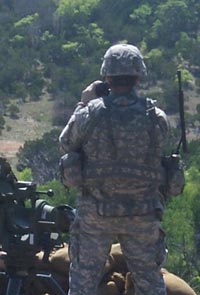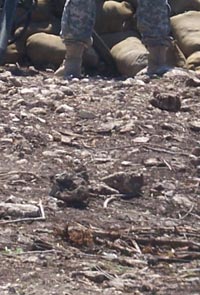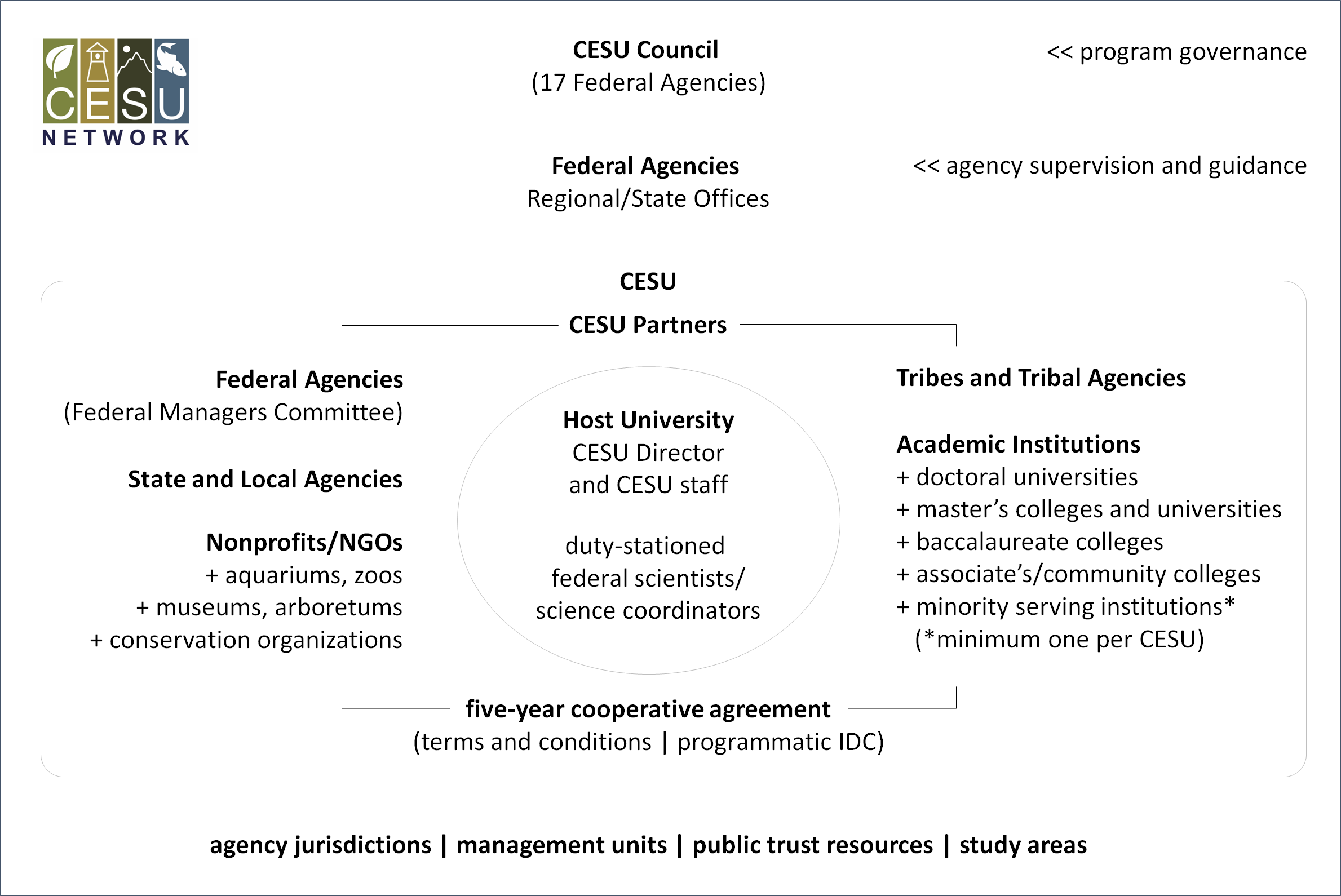ABOUT THE CESU NETWORK
Introduction
Cooperative Ecosystem Studies Units (CESUs) provide research, technical assistance, and education to federal land management, environmental, and research agencies and their partners. The partners serve the biological, physical, social, cultural, and engineering disciplines needed to address natural and cultural resource management issues at multiple scales and in an ecosystem context. The multi-disciplinary structure of CESUs makes them well-suited to address federal agency needs for sustainability science.
The CESU Network has the following objectives:
• provide usable knowledge to support informed decision making;
• ensure the independence and objectivity of research;
• create and maintain effective partnerships among the federal agencies and universities and other partners to share resources and expertise;
• take full advantage of university resources while benefiting faculty and students;
• encourage professional development of current and future federal scientists, resource managers, and environmental leaders; and
• manage federal resources effectively.
Partner Structure
The CESU Network is coordinated by the CESU Council that includes representatives of the federal agency partners who have signed a Memorandum of Understanding (MOU). The Network is led by a National Coordinator, appointed by the Council, and a small national program office staff.
The CESU Network partners are organized into seventeen units. CESUs function as "virtual" organizations, linking federal agencies and institutions to increase access to expertise and facilities. Each CESU is composed of federal agencies, a host university, and partner institutions.
1. Federal Agencies
Federal agencies participate in CESUs within the scope of their respective missions and administrative structure. Federal agencies are substantially involved in CESU activities, working closely with host universities and/or partner institutions on research, technical assistance, and education. With multiple federal agencies working together with institutional staff, the potential for cost sharing, improved efficiency, and cooperative activities is significantly increased. Collaborative projects among agencies are encouraged and are facilitated through the CESU agreements. The kind and background of agency employees working with CESUs vary, depending on the agency's responsibilities and requirements. Some individuals may be research scientists, others may be science administrators or resource/environmental management professionals. Those federal employees duty-stationed at a host university may conduct research; act as facilitators in delivering research, technical assistance, and education to federal resource/environmental managers and partners; engage the faculty and skills of the host universities in collaborative activities; teach advanced courses; and serve on graduate student committees. Field-based scientists (such as those located in a national park or forest) may be affiliated with the CESU through the host university or a partner institution. Federal agencies retain administrative oversight of the network, and federal agency participation in a CESU does not alter previous arrangements or cooperative agreements. CESUs create additional opportunities for interdisciplinary and multi-agency projects.
2. Host University
The host universities provide space, basic administrative support (secretarial, accounting, equipment), and access to university faculty, students, staff, and resources. The host university provides space for at least one federal research scientist as part of its responsibilities within the CESU agreement. The host is also responsible for coordinating administrative duties, including hosting a CESU website and facilitating communication among partners, and leading annual and strategic planning efforts. The CESU Network Council competitively selected the host universities, and it periodically reviews and reapproves each host university.
3. Partner Institutions
CESUs include tribes, universities, state local governemnt agencies, nongovernmental and nonprofit conservation organizations, and other nonfederal entities; these partners significantly expand the capabilities and skills of a CESU. A partner university may provide unique facilities, expertise, or access to research materials. New partners may join CESUs; existing partners review and approve new members.
Administrative Structure
Each CESU has an administrative structure that allows partners to work cooperatively and efficiently. These include the cooperative and joint venture agreement, a federal managers committee, a role and mission statement, and strategic and annual work plans (see CESU Network Structure Diagram, below).
1. Cooperative and Joint Venture Agreements
Federal, host, and partner institutions are linked to individual CESUs through cooperative and joint venture agreements that address overhead (also called indirect costs), cost-sharing, and other initial elements of cooperative ventures. CESU agreements allow each of the participating federal agencies to efficiently transfer funds and station employees at university partners while maintaining responsibility for agency-sponsored activities within CESUs.
2. Federal Managers Committee
CESUs are guided by a federal managers committee composed of field managers and additional representatives from participating federal agencies. The committee provides advice and guidance on science priorities and CESU activities, reviews strategic and annual work plans, and assists in evaluating CESU performance.
3. Role and Mission Statement
Each CESU prepared a role and mission statement that identifies research, technical assistance, education, and other services that it is especially qualified to provide. The role and mission statement includes the biogeographic area of concentration (such as the Colorado Plateau or the Southern Appalachian Mountains), a focus on particular ecosystem types (such as high deserts or urban areas), an emphasis on particular management regimes (such as wilderness and/or multiple use), or a combination of these themes. Hence, the role and mission statement reflects the mission and needs of the participating agencies and input from the host university and partner institutions. Each CESU's role and mission statement evolves as additional agencies become partners, the CESU develops expertise and experience, and as new issues and research opportunities emerge.
4. Strategic and Annual Work Plans
Strategic and annual work plans guide CESUs. Working together, CESU partners at an individual CESU develop multi-year strategic plans so that participating agencies can effectively allocate resources to meet both immediate and long-term needs including sharing of resources, collaborative projects, and flexibility to meet emerging needs. In addition, each CESU prepares a brief annual work plan for its research and service activities. The plan describes the CESU's ongoing research, anticipated projects, and products. The plans are used to ensure the timely delivery of useful research to managers, coordinate research activities, meet federal reporting requirements, and evaluate CESU performance.
CESU Network Structure Diagram




